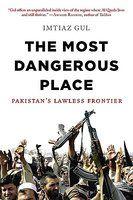 In a speech he gave on March 27, 2009, President Obama referred to the remote areas of the Pakistani frontier as, “for the American people…the most dangerous place in the world.” It is from this speech that Imtiaz Gul drew the title of his book, The Most Dangerous Place: Pakistan’s Lawless Frontier. Gul provides a comprehensive, inside look at the chaotic situation in Pakistan’s tribal areas, which have become an epicenter for extreme Islamic militancy.
In a speech he gave on March 27, 2009, President Obama referred to the remote areas of the Pakistani frontier as, “for the American people…the most dangerous place in the world.” It is from this speech that Imtiaz Gul drew the title of his book, The Most Dangerous Place: Pakistan’s Lawless Frontier. Gul provides a comprehensive, inside look at the chaotic situation in Pakistan’s tribal areas, which have become an epicenter for extreme Islamic militancy.
When Operation Enduring Freedom toppled the Taliban regime in Afghanistan in December 2001, thousands of al-Qaeda militants retreated into Pakistan’s easily penetrable border region, bringing with them bribes for tribal leaders and residents and infusing the region with their radical ideology. In order to educate his readers about this feared region, Gul details the trajectory of Pakistan’s tribal areas by exploring the challenges faced by each major tribal group. Militants pouring into the area capitalized on the absence of good governance and the rule of law. Gul maintains that the “lack of basic facilities, a poor education infrastructure, and dismal employment opportunities make the tribal areas an ideal hunting ground for Islamic militants seeking young warriors.”
Based on his intimate knowledge of the subject, both from personal experience as well as years of research, Imtiaz Gul certainly displays a high level of expertise in his writing. As a political analyst and Pakistani journalist, Gul has been reporting on Pakistan’s tribal areas and militant groups for over 25 years. Although the book can be sometimes confusing because of a plethora of actors and acronyms, it manages to thereby capture the inherent fractiousness of Pakistan’s frontier, where as many as 60 Pashtun tribes live. If all sub-clans are accounted for inside these Federally Administered Tribal Areas (FATA), the number rises to 400. Intertribal rifts, conflicts between militant organizations, suicide bombings, crackdowns by the Pakistani army, and U.S.-operated drone strikes all add to the chaos. Efforts by tribal leaders and the Pakistani army to expel militants also tend to have violent repercussions. For instance, by February 2009, militants destroyed as many as 182 predominantly girl’s schools in the Swat Valley.
The material presented in The Most Dangerous Place is of critical importance, for it educates readers about a region vital to U.S. and global interests. Through this book, Imtiaz Gul reveals the conditions that have allowed radical ideology to take root in these tribal areas as a result of sociopolitical neglect and relative geographic isolation. In order to establish some semblance of rule of law and good governance in the region, Gul argues that FATA must be properly integrated into Pakistan. He maintains that overall success in the region also demands that the United States and Pakistan mutually pursue a policy of trust-based, long-term engagement, a prerequisite for which is a concrete understanding of Pakistan’s tribal areas.
